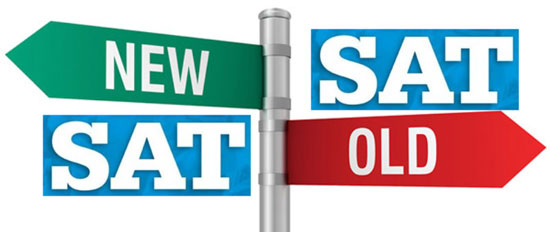The new SAT, starting in March 2016. As of latest update, The new SAT (2016) is changing drastically from the old SAT. The test design has been simplified when compared to Old SAT. In this post, we will show changes to the overall Scholastic Aptitude Test and individual aspects of the SAT Exam in a series of charts.

What’s the main difference between the New SAT and Old SAT?
The New SAT is substantially different from the old version of the exam. Actually the new test will be a little bit shorter while compared to old one. Scoring will revert to the classic 1600 scale: 200-800 for Evidence-Based Reading and Writing and 200-800 for Math. The Essay score will contain 3 scores ranging from 2-8, one each for Reading, Analysis and Writing, but will not be included in the 1600-based score.
Fast Summary: The Main Differences
| Old SAT | New SAT | |
| Timing | 3 Hours 45 Minutes | 3 Hours (+50 minute optional essay) |
| Sections |
|
|
| Guessing Penalty | 1/4 guessing penalty | no guessing penalty |
| Scoring | 600 – 2400 | 400 – 1600 Subscore and Cross-test Scores available |
Also See
Math: Old SAT vs New SAT
Math now has calculator-allowed and calculator-prohibited sections, and a much greater prominence on algebra, practical problem solving and some more advanced math topics. For better reference follow Syllabus and Exam pattern provided above links.
| Section Components | Old SAT Math | New SAT Math |
| Total time | 70 minutes | 80 minutes |
| Sections | 3 (calculator use permitted) | 2 (one with calculator use permitted, one with no calculator) |
| Grading scale | 200-800 points | 200-800 points |
| Questions | 54 questions total 44 multiple-choice 10 fill-in-grid One 16-question section One 18-question section One 20-question section | 58 questions total 20 no-calculator questions 38 calculator questions 45 multiple-choice questions 13 grid-in questions |
| Skills covered | Numbers and operations, 11-13 questions Algebra and functions, 19-21 questions Geometry and measurement, 14-16 questions Data analysis and statistics, 6-7 questions | Heart of Algebra, 19 questions (linear equations, systems of linear equations, and inequalities) Problem Solving and Data Analysis, 17 questions (ratios, proportions, percentages, units, quantitative data, probabilities) Passport to Advanced Math, 16 questions (equivalent algebraic expressions, quadratic equations, exponential functions, other nonlinear equations and functions) Additional Topics in Math, 6 questions (basic trigonometry, geometry) |
The best way to understand what this Scholastic Aptitude Test is about is to visit the College Board’s website (https://www.collegeboard.org/)


